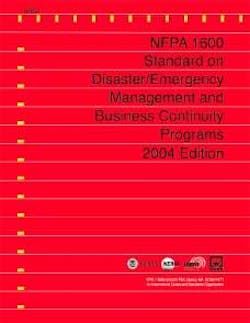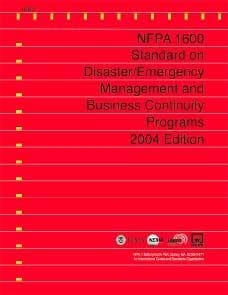NFPA 1600: Ground rules for disaster-preparedness
The standard is rich with references to emergency-management organizations, other resources, and programs.
Before the natural disaster of Hurricane Katrina and the humanitarian disaster of 9/11-in fact, before the first World Trade Center bombing in 1993-specifications were being established for a uniform disaster-preparedness plan. In the early 1990s, initial work began on what is today the National Fire Protection Agency’s (NFPA-www.nfpa.org) NFPA 1600 Standard on Disaster/Emergency Management and Business Continuity Programs. The most recent edition of the standard was issued in 2004.
Historical progress
NFPA 1600’s history dates back to 1991. Much of the following five paragraphs is excerpted directly from the standard’s 2004 edition, in the section entitled “Origin and Development of NFPA 1600.”
The NFPA Standards Council established the Disaster Management Committee in January 1991. The committee was given the responsibility for developing documents relating to preparedness for, response to, and recovery from disasters resulting from natural, human, or technological events.
The first document that the committee focused on was NFPA 1600, Recommended Practice for Disaster Management. NFPA 1600 was presented to the NFPA membership at its 1995 annual meeting. That effort produced the 1995 edition of NFPA 1600.
For the 2000 edition, the committee incorporated a “total program approach” for disaster/emergency management and business continuity programs in its revision of the document from a recommended practice to a standard. They provided a standardized basis for disaster/emergency management planning and business continuity programs in private and public sectors by providing common program elements, techniques, and processes.
The committee provided expanded provisions for enhanced capabilities for disaster/emergency management and business continuity programs so that the impacts of a disaster would be mitigated, while protecting life and property. The chapters were expanded to include additional material relating to disaster/emergency management and business continuity programs. The annex material was also expanded to include additional explanatory material.
The 2004 edition contains updated terminology. The committee added a table in Annex A that creates a crosswalk among FEMA’s CAR (Federal Emergency Management Agency’s Capability Assessment for Readiness), NFPA 1600, as well as BCI (Business Continuity Institute) and DRII (Disaster Recovery Institute International) professional practices. The committee added significant additional informational resources to Annexes B, C, D, and E.
The document continues to be developed in cooperation and coordination with representatives from FEMA (www.fema.gov), the National Electrical Manufacturers Association (NEMA-www.nema.org), and the International Association of Emergency Managers (IAEM-www.iaem.com). This coordinated effort was reflected in the expansion of the standard’s title for the 2000 edition to include disaster and emergency management, as well as information on business continuity programs.
Chapters and verses
The standard includes five chapters, five annexes, and an index. One of the five chapters is administrative in nature, and a second, titled Referenced Publications, is reserved. The three other chapters cover definitions, program management, and program elements.
Chapter 5, titled Program Elements, is the lengthiest and most detailed. Within that chapter is Section 5.9 Communications and Warning. Section 5.9.1 states, “Communications systems and procedures shall be established and regularly tested to support the program.” That is followed by 5.9.2: “The entity shall develop and maintain a reliable capability to notify officials and alert emergency response personnel.”
Section 5.9.3 states that protocols, processes, and procedures for these systems shall be developed, periodically tested, and used to alert people potentially impacted by an actual or impending emergency. And Section 5.9.4 says that a program shall address communications needs and capabilities to execute all components of the response and recovery plans.
NFPA 1600 and homeland security
In the aftermath of the 2001 terrorist attacks on the United States, the NFPA 1600 standard garnered significant and close attention from federal authorities, in particular the National Commission on Terrorist Attacks upon the United States (commonly known as the 9/11 Commission). That commission recommended NFPA 1600 as a nationwide specification for disaster preparedness among the private sector. In correspondence between the commission and the Department of Homeland Security (DHOS), it is noted that the private sector controls approximately 85% of the United States’ infrastructure.
The DHOS has taken further steps to encourage adoption of NFPA 1600, or at the very least adoption of the standard’s spirit and intentions. The DHOS has officially endorsed the standard, and has published a brochure entitled “Every Business Should Have a Plan,” which is based on it.
The DHOS characterizes its document as providing “common sense measures business owners and managers can take” to prepare for disasters, particularly terrorist attacks. The brochure offers continuity-planning directions, including such topics as emergency supplies, employees with disabilities, evacuation considerations and plans, and fire safety.
Additionally, one section of the brochure tells companies to plan for utility disruptions. “Carefully examine which utilities are vital to your business’s day-to-day operation,” it advises. “Speak with service providers about potential alternatives and identify backup options.”
NFPA 1600 has made other rounds within the DHOS realm. In April of this year, a Homeland Security Advisory Council task force issued a document entitled Report on the Implementation Plans for Maritime Transportation Security, Maritime Commerce Security, and Maritime Infrastructure Recovery. Part of the report that addressed a maritime infrastructure recovery plan referenced the 9/11 Commission’s recommendation to adopt NFPA 1600 as a national standard of practice.
The task force, in its own words, “felt it would be prudent to, at a minimum, cross-reference the 9/11 Commission recommendations,” adding later, “a more robust plan would include recommendations and programs that seek to increase the system resiliency within the maritime community beyond the minimum standards of business continuity established in NFPA 1600.”
That final reference hits the core of the issue to a large extent. NFPA 1600, like other standards, is meant to set a minimum compliance level. Disaster preparedness was thrust onto the front page after 9/11 and the nation, many would argue, suffered its first failure of preparedness with Hurricane Katrina. NFPA 1600 may best be described as a framework, rather than an all-inclusive how-to manual. Jurisdictions and private organizations bear the burden of developing and following through on the details of preparedness planning-a burden that pales in comparison to that of failing to plan.
PATRICK McLAUGHLIN is chief editor of Cabling Installation & Maintenance.

